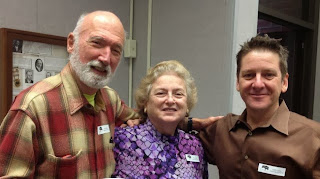Friday, December 06, 2013
Photos from Altshuller Institute TRIZCON2013
Thanks to Isak Bukhman for these informal memory shots! Top: Past president Larry Smith and current president Chuck Roe. Middle: Isak with Tim Brewer. Bottom: John Terninko, Ellen Domb, and Dave Conley.
Altshuller Institute TRIZCON2013, Waterbury CT USA Dec. 5, 2013
Our global
TRIZ travels took us to Waterbury, CT, USA on Dec. 5 for the Altshuller
Institute’s TRIZCON2013 at the campus of Post University. This was a hybrid meeting with about 15
people present at the university and another 20 on-line live, and about 40 more
registered to listen in later to the recorded event. There were a lot of lessons learned for
future applications of webinar technology to this kind of meeting. Everyone (well....) handled the problems
with patience and good humor.
The program
was a nice mix of TRIZ case studies and papers and panels about what’s
happening now in TRIZ. Keynote
speaker Larry Smith (Past President of the Altshuller Institute) presented history of TRIZ, an overview of
TRIZ methodology, and some very nice non-traditional TRIZ cases. I was particularly impressed by his function
modelling of US government small business programs, where the congressional
staff got so much insight from the model, they didn’t even want to learn
problem solving skills! The application
of TRIZ to revising the education system for the American Society for Quality
produced radical changes in the business, rapid implementation, and a very
useful case study of business application of TRIZ.
Dave Conley,
Isak Bukhman, and I were the panelists for “Utilization of TRIZ in the World” organized
by Don Coates. Readers of this blog are
familiar with the active world conference schedule and adventures like the
Dunavision series of seminars along the Danube River Valley, so I won’t repeat
those stories here. Personal
observations were offered of the differences in TRIZ training and applications
in different world regions.
The afternoon
case study was 5 case studies. The
agenda follows, with a very brief summary of each paper. Check www.aitriz.org next week to find out how to access
recordings of the webinars.
David
Conley
|
Wireless
Power System Improvement – Su-Field Analysis Application. Comprehensive case study, and a neat
technique for looking at a system by means of both Su-Field modeling and
Subject-Object-Action modeling, then using the standard solutions and
scientific effects to solve a real problem that all traveling technology
users understand—powering devices without wires.
|
Victor
Fey & John Cooke
|
From
Strategy to Real Business Impact. This
is the story of the Flavia single cup coffee machine, and it showed
comprehensive use of TRIZ to understand the business situation, the
competition, and the development of the details of the design of the machine
itself. Importing technology from
other industries (using entrained air in a water jet to avoid having a nozzle
that touches the milk and needs to be cleaned) became the foundation for an
entire product line.
|
Robert
Joseph
|
Relationship
of TRIZ Principles to Deformity Correction in Surgery. Some participants were a bit queasy from
Dr. Robert Joseph’s pictures of deformed feet and the surgical procedures
used to correct the problems, but all were fascinated by the demonstrations
of many of the 40 principles for problem solving in these surgical
protocols.
|
Noel
Leon
|
“Research
on the future of TRIZ: Steps toward the Integration of TRIZ and Design
Thinking” was the title but the work
ranges much wider, encompassing Blue Ocean Strategy, QFD, and other elements
of Design for Six Sigma as well. The
group at TEC in Monterrey MX is conducting research in many aspects of
strategy, particularly focused on product development, and Professor Leon
will be creating a new curriculum based on this research.
|
Tim Brewer
|
Crowd
sourcing and Crowd funding business models.
The TRIZ complete (technical) system model (both the 5 element and 6
element versions) and the nine windows model were used to study these
emerging business models that greatly accelerate product development and radically
change who bears the risk in the invention process. Other participants were signing up as “influencers”
and sponsors before Tim finished speaking!
|



